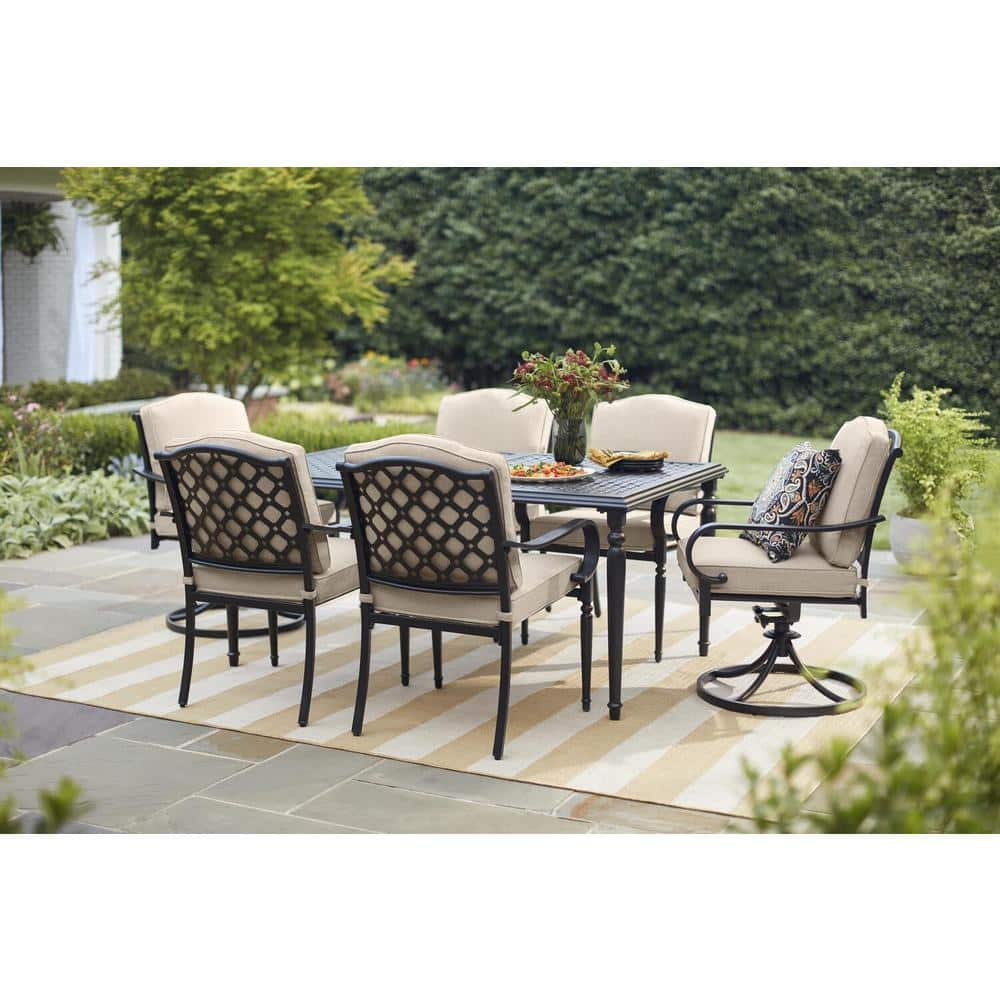Hampton Bay Laurel Oaks 7-Piece Brown Steel Outdoor Patio Dining Set with Standard Putty Tan Cushions
7-piece set includes a dining table and 6 chairs with cushions. Comes with Putty Tan Cushions. Weather-resistant and powder coated for long-lasting use.
Providing comfortable and stylish seating for your family and friends, this 7-Piece Outdoor Dining Set from the Laurel Oaks Collection will be the focal point of your sunroom, patio area, or poolside. The functional dining table features a beautiful stamped pattern that provides a brilliant visual appeal. The cushions are stuffed with super-soft, down-like fill for a custom seating experience. This decorative set is weather-resistant and boasts beautiful powder coated framework for a long-lasting use. This set is part of Home Depot’s Choose Your Own Color program to create a cohesive, polished look; choose your own slipcover color for the cushions to reflect your style and inspire your home.
- Sturdy, durable steel frames
- Weather-resistant high-performance powder-coating
- Chair back have nice pattern panel
- Dining table features a beautiful stamped pattern which provides a brilliant visual appeal
- Chair size: 23.8 in. W x 29.72 in. D x 35 in. H
- Table size: 63.7 in. W x 40 in. D x 28.6 in. H
- CushionGuard acrylic fabric that resists fading, repels water, stains and spills all while retaining the fabrics natural softness.
- 1-year fabric warranty
- Cushions are not waterproof, please keep the cushions covered when not in use
Additional information
| Chair Back Height (in.) | 34.6 |
|---|---|
| Chair Back Width (in.) | 19.68 |
| Chair Depth (in.) | 29.5 |
| Chair Height (in.) | 34.6 |
| Chair Seat Depth (in.) | 20.47 |
| Chair Seat Width (in.) | 16.5 |
| Chair Width (in.) | 23.6 |
| Cushion Thickness (in.) | 3.54 |
| Seat Height (in.) | 15.74 |
| Table Height x Length x Width (in.) | 28 x 63.5 x 40 |
| Fabric Warranty | 3 year limited warranty |
| Frame Warranty | 3 year limited warranty |
| Manufacturer Warranty | 3 year limited frame and fabric warranty |






by Andrea
Quality is great, very pretty. The grey is lighter than in the photos.
by Helen
The Hampton Bay Laurel Oaks brown steel outdoor dining set is perfect for lanai use. The design is traditional and the comfort remarkable. Very pleased with this purchase.
by Susan
Easy to assemble if you followed the instructions.
by Lazy
Like the design, quality and price. Delivery was fast.
by Copterits
I haven’t used it yet. But it appears to be really sturdy & strong. It was very easy to assembly. The pillows seem to be really firm and the color chilli is a little darker then expected. But doesn’t take away from the set. Can’t wait too actually get some use out of it. Send another review in another year. So I can give a actual review.